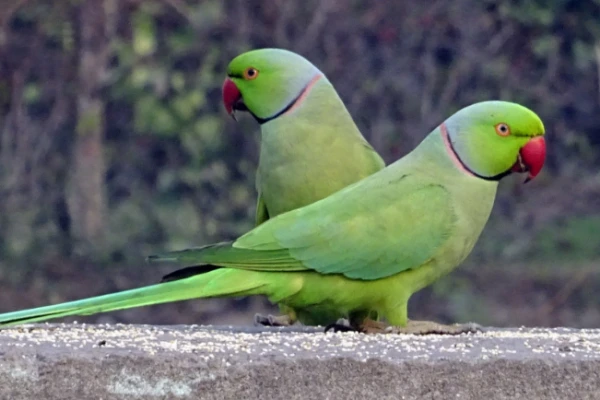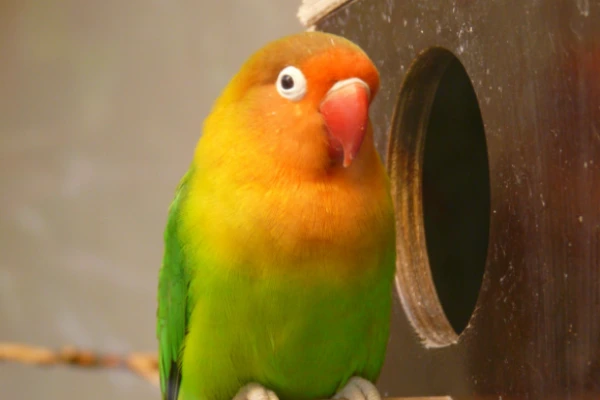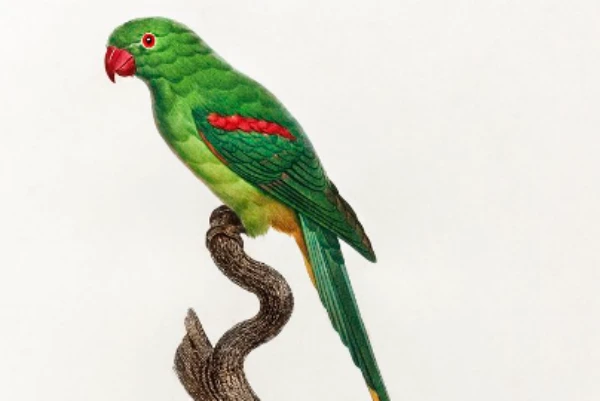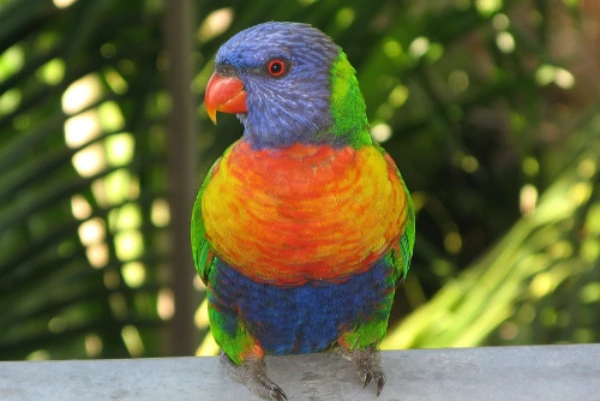Parrots are the most loveable bird of all because of their mimicking ability. Can you name several parrot species? The answer is probably no. After all, there are hundreds of parrot species present on the earth.
If someone asks us how a parrot looks, the most common answer is that parrots are green with red beaks. This makes me curious to know how many green parrots with red beaks are present in the world. So let’s go on a tour of the world of green parrots with red beaks.
Here we go.
20 Types Of Green Parrots with Red Beaks
1. Rose-Ringed Parakeet

- Scientific name: Psittacula krameri
- Identification: Black and red band on the neck
The rose-ringed parakeet, also known as the ringneck parrot or Kramer parrot, is a medium-sized parrot. You can easily find these parrots in the green land and fields of Africa and the Indian Subcontinent.
Moreover, you might be amazed that these green parrots with red beaks are sexually dimorphic. The adult male has a red and black band around him, while the hen and immature birds either show no neck rings or display shadow-like pale to dark grey neck rings.
Furthermore, the parrot has green as its prominent body color and a red beak. They can grow to an average of 40 cm in length. And one of the most distinctive features, or, we can say, abilities, is that these captive individuals can be taught to speak.
2. Fischer’s Lovebird
- Scientific name: Agapornis fischeri
- Identification: Dark orange plumage on the neck
Next is Fischer’s lovebird, a small, green lovebird with a dominance of green on the chest, back, and wings.
Other than that, you can identify this parrot because of its distinctive golden yellow neck, and as they grow as adults, they get dark orange in color.
Its beak is bright red, while the top of the head is olive green. Further, the upper surface of the tail has purple or blue feathers. Young birds are similar to adults but duller and have brown markings on their mandibles.
3. Yellow-collared Lovebird
- Scientific name: Agapornis personatus
- Identification: yellow breast and collar
The yellow-collared lovebird is a famous bird by various names; you can call it a masked lovebird, a black-masked lovebird, or an eye-ring lovebird. This is a small green parrot with a red beak, a black head, and white eye rings.
Both males and females have the same identical external appearance. As its name suggests, the parrot has a yellow breast, collar, and around-the-neck nape. This species can grow up to 14.5 cm in length.
4. Black-cheeked Lovebird
- Scientific name: Agapornis nigrigenis
- Identification: black cheeks and orange feature around the neck
The black-cheeked lovebird is a small parrot that mainly has a green body with a brown head, a red beak, and white eye rings. The parrot can grow to a maximum length of 14.
Other than that, the parrot has a brown forehead, forecrown and brownish-black cheeks, and a throat.
Also, they have an orange bib below the throat that fades to yellowish-green and white eye rings. Mostly, adults have bright red beaks, while juveniles have a more orange bill. Talking about its vocalizations, they are loud and have piercing shrieks.
5. Red-headed Lovebird

- Scientific name: Agapornis pullarius
- Identification: red head and neck
Following that is a red-headed lovebird, also known as a red-faced lovebird. This parrot measures 15 cm in length. Do you think these parrots are native to Africa? Talking about appearance, its red head extends from the top of the beak to the mid-crown and eyelid margins.
While the female has an orange head that is less well-demarcated than the male’s redhead, the underside of the wings is lighter green.
You can distinguish between males and females on the basis of their beaks, as the adult male has a red beak while the female’s is paler red.
6. Lilian’s Lovebird
- Scientific name: Agapornis lilianae
- Identification: Orange coloration on its upper chest
Another parrot is Lilian’s Lovebird, also known as Nyasa Lovebird. This is a small African green parrot with a red beak that has an orange coloration on its upper chest and head.
It is 13 cm long and is the smallest parrot in mainland Africa. In captivity, it is rare and difficult to breed.
One more thing you might not know about Lilian’s lovebird is that they have a familiar appearance with Fischer’s lovebird, but you can distinguish it on the basis of its olive-green hood and blue rump.
Further, it is also similar to the rosy-faced lovebird, which has a more clearly demarcated orange coloration and lacks a white eyering. Moreover, Lilian’s lovebirds feed on grass seeds, millet, wild rice, flowers, and other species.
7. Black-winged lovebird
- Scientific name: Agapornis taranta
- Identification: Black feather at end of the wings
The black-winged lovebird is a large parrot, mostly green, in the parrot family. Also known as the Abyssinian lovebird. It is sexually dimorphic; the dimorphism becomes apparent in juvenile birds after their first molt.
Further, both male and female black-winged lovebirds are mostly green, with the adult male having a red forehead and a ring of red feathers around its eyes.
The tail is black-tipped, with yellowish feathers below the tail. Other than that, their rump and feathers above the tail are light green. The common feature among males and females is that they both have a red beak and gray feet.
8. Scaly-breasted lorikeet
- Scientific name: Trichoglossus chlorolepidotus
- Identification: yellow breast with green edge
The next one is the scaly-breasted lorikeet, an Australian bird found in the eastern range. It is well known for its yellow breast feathers edged with green.
Scaly-breasted parrots measure 23 cm in length and have a scaly appearance with an emerald-green crown, blue-tinged sides, and yellow feathers.
Moreover, the tail is green with orange-red markings, while the lower flanks, thighs, and undertail covers are green with yellow markings. Other features you should know about this parrot are that it has orange-red eyes and a dark coral-red beak.
9. Layard’s parakeet
- Scientific name: Psittacula calthrapae
- Identification: blue tail with a yellow tip
Layard’s parakeet is a green parrot native to Sri Lanka, measuring 29 cm in length with a 13 cm tail.
Its adult features a bluish-grey head and back, a green collar, a black chin stripe, and a blue-tipped yellow tail. The male’s upper mandible is red, while the lower mandible is brown.
10. Coconut lorikeet
- Scientific name: Trichoglossus haematodus
- Identification: red breast
The coconut lorikeet, also known as the green-naped lorikeet, has a prominent green body with a red beak. This species of parrot has a maximum length of 25–30 cm and weighs around 109–137 g.
Its beak is red with shades of orange, and its head is dark blue, fading to brown at the neck. Further, they have a yellow collar, green upperparts, a red breast, a green belly, and a green tail. The male’s iris is bright red, while the female’s is orange-red.
11. Long-tailed parakeet
- Scientific name: Psittacula longicauda
- Identification: red cheeks and black stripes
Another green parrot with a red beak is the long-tailed parakeet, also known as Burung Bayan Nuri in Malay. This is a medium-sized green parrot found in the Andaman and Nicobar Islands, Sumatra, Borneo, and Peninsular Malaysia.
This species of green parrot with a red beak has red cheeks and black stripes. Most females have a red beak, while the male is brighter-colored and has a black bill.
12. Red-flanked lorikeet
- Scientific name: Charmosyna placentis
- Identification: red plumage on the head and sides
The red-flanked lorikeet is a species of green parrot commonly seen on the landscape of Mollucas, New Guinea, and the Bismarck Archipelago. The parrot has a super attractive red plumage on the head and sides.
Its natural habitats are subtropical or tropical moist lowland forests and mangrove forests. It is also known as Burung Bayan Nuri; the male is brighter-colored and has a black bill, while the female has a red beak.
13. Musk lorikeet
- Scientific name: Glossopsitta concinna
- Identification: Red forehead with blue crown
The musk lorikeet is a 22 cm long lorikeet found in south-central or eastern Australia. Its distinctive features include its red forehead, blue crown, and yellow band on its wing, and red upper and lower mandibles near its base. The little lorikeet and purple-crowned lorikeet were previously included in the genus.
14. Lord Derby’s Parakeet
- Scientific name: Psittacula derbiana
- Identification: blue-purple head
Next comes Lord Derby’s parakeet, also known as the Derbyan parakeet, which is a parrot species that likes to live in moist evergreen forests. You can easily find them in the forest ranges of India, Tibet, Sichuan, and Yunnan.
They are 45-50 cm long and are sexually dimorphic. Talking about its appearance, they have a green color plumage with black lores and lower cheeks, a bluish-purple crown, and pale yellow eyes.
Other than that, Their throat, breast, abdomen, and under-wing coverts are greyish blue to lavender.
Also, their thighs and vent area are yellowish green with blue edging on some feathers. Male birds have a red upper beak with a yellow tip, while females have an all-black beak.
15. Alexandrine parakeet

- Scientific name: Psittacula eupatria
- Identification: light blue-grey sheen on its cheeks
The Alexandrine parakeet, or parrot a medium-sized parrot native to South Asia and Southeast Asia.
Its appearance is very similar to other green parrots, it is predominantly green with a light blue-grey sheen on its cheeks and nape, a yellow-green abdomen, a red patch on the shoulders, and a massive red beak with yellow tips.
Also, the upper side of the tail is green, while the underside is yellow. Mostly, Adults are sexually dimorphic, with adult males having a black stripe across their lower cheeks and a pink band on their nape.
16. Olivehead lorikeet
- Scientific name: Trichoglossus euteles
- Identification: yellow head and breast
The olive-headed lorikeet, also known as the perfect lorikeet, is a species of parrot found in Timor and nearby islands. It is mainly green, 24 cm long, with an olive-colored head, orange-red beak, red irises, and grey legs.
Both males and females have identical appearances, with juveniles having slightly greener heads, brown beaks, and brown irises.
17. Mindanao lorikeet
- Scientific name: Trichoglossus johnstoniae
- Identification: dark purple band on the head
The Mindanao lorikeet, also known as Mount Apo lorikeet, is a 20 cm (8 in) long parrot species in the Psittaculidae family, endemic to Mindanao, Philippines. Its front is green, with a red face and a dark purple band on the head.
It has gray feet, an orange beak, dark gray eyes, and a red iris. Both males and females have similar appearances, with the young having less red face and brown eyes, iris, and beak. They eat small insects like fireflies and spiders.
18. Ornate lorikeet
- Scientific name: Trichoglossus ornatus
- Identification: purple-blue head above its eyes and a red face below
The ornate lorikeet, also known as the ornate lory, is a species of parrot in the Psittaculidae family, endemic to the Sulawesi archipelago in Indonesia. It is mainly green, 25 cm long, with a purple-blue head above its eyes and a red face below.
It lacks a collar at the back of the neck like rainbow lorikeets. Its chin-to-chest has transverse stripes and bars of red and blue. Its abdomen is green with sparse variable yellow scalloping.
19. Rainbow lorikeet

https://in.pinterest.com/pin/Af9SOt4WhXMmiY5F4QS0hSrb09HMRg58rNxPRaQhFtXQ61AlAZQZGFc/
- Scientific name: Trichoglossus moluccanus
- Identification: greenish-yellow nuchal collar
The rainbow lorikeet is a medium-sized parrot found in Australia, primarily along the eastern seaboard from northern Queensland to South Australia.
It measures 25 to 30 cm in length and weighs 75 to 157 g. The bird’s plumage is bright and colorful, with a deep blue head, greenish-yellow nuchal collar, green upper parts, orange/yellow chest, deep blue belly, and green thighs and rump.
In flight, a yellow wing bar contrasts with red underwing coverts. The sexes are not visually distinguished.
20. Great-billed parrot
- Scientific name: Tanygnathus megalorynchos
- Identification: yellow wing markings
The great-billed parrot, also known as the Moluccan parrot or island parrot, is a large, medium-sized green parrot species with red beak and yellow markings on its wings.
It is found in forests, mangroves, and plantations in lowlands and foothills. Unlike Blue-backed and Black-lored Parrots, it has yellow wing markings. The female is typically smaller than the male, but the sexes are similar.
Found in the southeast Asian islands of Maluku, Raja Ampat, Talaud, Sangir, Sarangani, and nearby small islands, the great-billed parrot primarily eats fruits.
CONCLUSION:
So, these are some of the green parrots with red beaks, but there are few of them. Still, there are many species of green parrots with red beaks. If you want to learn more about them, keep track of it with us on HowItSee.
Also Read:

As a content writer, I like to write about different niches. I have a curiosity about nature and animals. And like to learn about them. Through my writing, I like to share my experience and knowledge with you. I hope you are enjoying it too.
